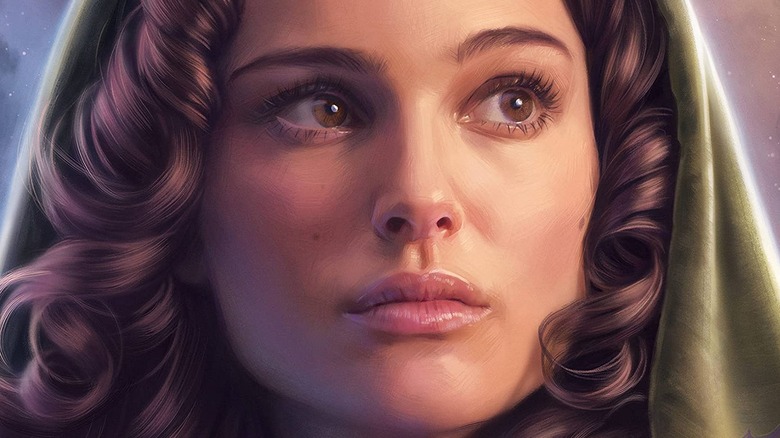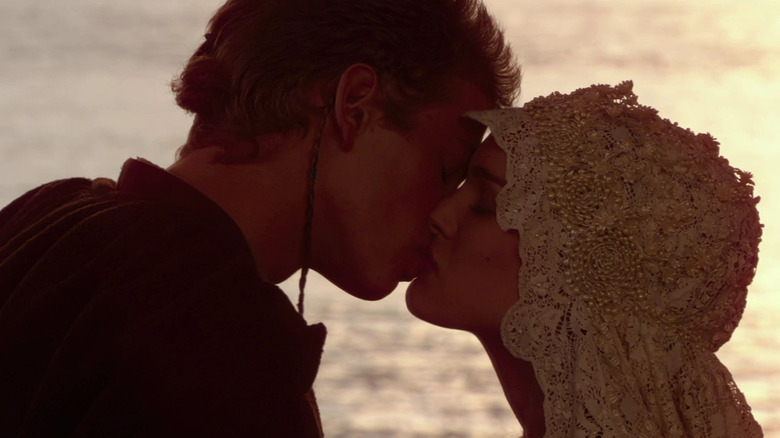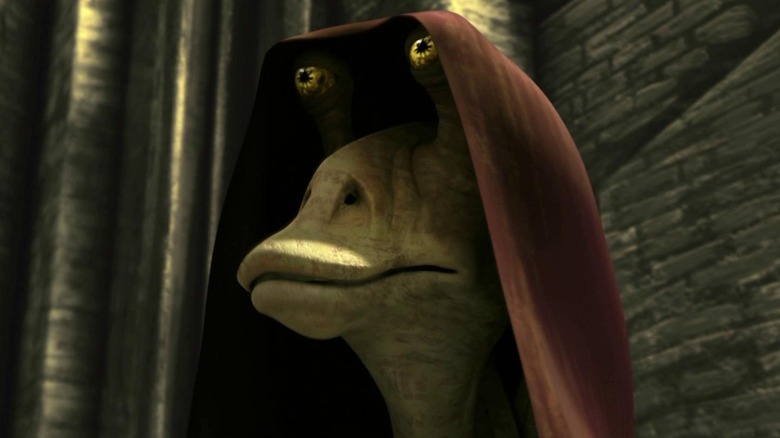Star Wars: Queen's Hope Sheds New Light On Anakin And Padmé
This will contain spoilers for "Star Wars: Queen's Hope."
E.K. Johnston is no stranger to "Star Wars." "Queen's Hope" is her fourth book in the world and is the third in her trilogy about Padmé Amidala. This book should feel familiar to anyone who is a fan of "Attack of the Clones" and "Star Wars: The Clone Wars."
"Queen's Hope" starts in the hours after the Clone War has begun and before the wedding of Anakin Skywalker and Padmé, showing us the dynamic between the two love birds at the end of "Attack of the Clones" and carries on into the beginning of the war and the cloak and dagger secrecy behind keeping their marriage secret. Anakin is sent on a dangerous mission for the Jedi and, naturally, Padmé has a mission of her own. But, with the start of the war, there are too many things happening in the Senate that require her attention. Being adept at using doubles, Padmé recruits her good friend and former handmaiden Sabé to double for her in the Senate. This leads to problems since she's never doubled Padmé for such a long period of time before, and definitely not without the more ostentatious makeup of Queen Amidala. And there's something else Sabé doesn't know about: the marriage.
This book pours tension and emotion like gasoline onto the fire of the Clone Wars and delivers a book that pays beautiful respect to the source material and adds to it in important ways.
The relationships
Some might show up coming to read about the relationship between Anakin and Padmé, but the real meaty relationship chunk of the story comes with the story between Padmé and her former handmaiden Sabé. Sabé is the handmaiden that was played by Keira Knightly in "The Phantom Menace" and has been given an increasingly important role in these books (as well as the recent comic books.) It's really in the relationship between Padmé and Sabé eroding that the real drama of the book takes place. Ultimately, the book is about the erosion of friendship between the two as they grow in different directions. It feels like heartbreak as they come to the realizations that the state of the galaxy and their competing goals are coming between them. They've grown up and their childhood friendship did not endure the years and distance between them. For a book billed as YA, it feels like a much more mature and adult story than the other two in the trilogy, but that's natural as the characters are adults now.
That's not to say that there is no exploration of the relationship between Anakin and Padmé. There absolutely is. And Johnston tackles the curiosity over their attraction and why Padmé sticks to his side, even after the slaughter of the Tusken Raiders.
The best scene in the book, though, is when Sabé and Anakin first meet. Sabé, doubling as Padmé is sleeping in her bed. When Anakin sneaks in for a secret tryst, he's shocked to discover his wife missing and the ensuing scene is, hands down, one of the best in the book. If you're going to read it for one reason, let it be this single scene.
Things to watch out for
E.K. Johnston left a lot of goodies in the text for fans of "Star Wars: The Clone Wars" and really "Star Wars" in general. The biggest thing in this book might be the use of Beru Whitesun, transforming her into a strong side character rather than just dressing for the story. There's no guarantee that this story thread will be picked up in the "Obi-Wan Kenobi" series coming in May, but Johnston casts Luke's aunt as someone who worked tirelessly to free slaves on Tatooine and knew Sabé in that effort, connecting her closer to the Skywalker family than we had previously realized. The book states that it was Beru who removed Shmi Skywalker's slave chip and worked to do the same for other slaves of Tatooine. It was a touching moment between some of the most maternal characters in "Star Wars."
The next most important moment would be Johnston's inclusion of a trans clone serving in the army who goes by the name of Sister. Having her clone brothers accept her without question and allow her to continue to serve is a powerful message to send. It's good for "Star Wars," it's good for trans folks who will read this book, and it's good for the world.
Further connections
As for moments in the text that add to the wide tapestry of "Star Wars" some of my favorites were nods to specific episodes of "The Clone Wars." At one point, Anakin leaves his cloak in a closet aboard Padmé's ship, paving the way for Jar Jar's ruse in the episode "Bombad Jedi." There were many cameos as well, like Padmé's uncle, the Rodian senator Onaconda Farr. Two of everyone's favorite Besalisks make appearances in the book: Pong Krell is at a reception in the Jedi temple and the narrative pays a visit to Dexter Jettster, the diner chef from "Attack of the Clones."
The book also tackles some of the complications of the Jedi Padawan Barris Offee in a very short amount of time. Offee was the Padawan who turned against the Jedi order and framed Ahsoka for murder, setting in motion the events that sent her away from the path of the Jedi. "Queen's Hope" also obliquely makes references to a pair of books that starred Barris from the "Star Wars: Legends" timeline referred to as "The Medstar Duology." Those books are basically "M*A*S*H" set during the Clone Wars and Barris plays a major part. Even though they're no longer canon, they're worth checking out if you're looking for more on her after reading this.
The verdict
E.K. Johnston understands the prequel films and the relationships of the characters and the urgency of the narrative better than most people and is able to weave stories around it that add to its context and make it even better. She's a clever writer and leaves invested readers in tears on more than one occasion through the course of the narrative. This book caps off her unofficial Padmé trilogy, but it also serves as a perfect introduction to the intrigue of the television series "Star Wars: The Clone Wars." It's bold, it takes risks, and perfectly captures the voice and spirit of the movies and stories it spends its time winding through.
This might be the best book in the "Star Wars" canon Johnston has written. And if you have any interest in the characters, situations, or era she's writing in, it's a must read. It's definitely not for everyone, but it's certainly for fans of Anakin and Padmé, "Star Wars: The Clone Wars," and the prequels.
"Star Wars: Queen's Hope" is available now at bookstores everywhere.




